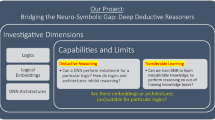Abstract
Knowledge based artificial networks networks have been applied quite successfully to propositional knowledge representation and reasoning tasks. However, as soon as these tasks are extended to structured objects and structure-sensitive processes it is not obvious at all how neural symbolic systems should look like such that they are truly connectionist and allow for a declarative reading at the same time. The core method aims at such an integration. It is a method for connectionist model generation using recurrent networks with feed-forward core. After an introduction to the core method, this paper will focus on possible connectionist representations of structured objects and their use in structure-sensitive reasoning tasks.
Preview
Unable to display preview. Download preview PDF.
Similar content being viewed by others
References
Andrews, R., Diederich, J., Tickle, A.: A survey and critique of techniques for extracting rules from trained artificial neural networks. Knowledge–Based Systems 8(6) (1995)
Bader, S., Hitzler, P., Witzel, A.: Integrating first-order logic programs and connectionist systems — a constructive approach. In: Proceedings of the IJCAI 2005 Workshop on Neural-Symbolic Learning and Reasoning, NeSy 2005, Edinburgh, UK (2005)
Ballard, D.H.: Parallel logic inference and energy minimization. In: Proceedings of the AAAI National Conference on Artificial Intelligence, pp. 203–208 (1986)
Bishop, C.M.: Neural Networks for Pattern Recognition. Oxford University Press, Oxford (1995)
d’Avila Garcez, A.S., Broda, K., Gabbay, D.M.: Neural-Symbolic Learning Systems: Foundations and Applications. Springer, Heidelberg (2002)
d’Avila Garcez, A.S., Lamb, L.C., Gabbay, D.M.: A connectionist inductive learning system for modal logic programming. In: Proceedings of the IEEE International Conference on Neural Information Processing ICONIP 2002, Singapore (2002)
d’Avila Garcez, A.S., Lamb, L.C., Gabbay, D.M.: Neural-symbolic intuitionistic reasoning. In: Design and Application of Hybrid Intelligent Systems, pp. 399–408. IOS Press, Amsterdam (2003)
d’Avila Garcez, A.S., Zaverucha, G., de Carvalho, L.A.V.: Logic programming and inductive learning in artificial neural networks. In: Herrmann, Ch., Reine, F., Strohmaier, A. (eds.) Knowledge Representation in Neural Networks, Berlin, pp. 33–46. Logos Verlag (1997)
Elman, J.L.: Structured representations and connectionist models. In: Proceedings of the Annual Conference of the Cognitive Science Society, pp. 17–25 (1989)
Fitting, M.: Metric methods – three examples and a theorem. Journal of Logic Programming, 113–127 (1994)
Fritzke, B.: Vektorbasierte Neuronale Netze. Shaker Verlag (1998)
Funahashi, K.-I.: On the approximate realization of continuous mappings by neural networks. Neural Networks 2, 183–192 (1989)
Hitzler, P., Hölldobler, S., Seda, A.K.: Logic programs and connectionist networks. Journal of Applied Logic 2(3), 245–272 (2004)
Hölldobler, S., Kalinke, Y.: Towards a massively parallel computational model for logic programming. In: Proceedings of the ECAI 1994 Workshop on Combining Symbolic and Connectionist Processing (ECCAI), pp. 68–77 (1994)
Hölldobler, S., Kalinke, Y., Störr, H.-P.: Approximating the semantics of logic programs by recurrent neural networks. Applied Intelligence 11, 45–59 (1999)
Hölldobler, S., Kurfess, F.: CHCL – A connectionist inference system. In: Fronhöfer, B., Wrightson, G. (eds.) Dagstuhl Seminar 1990. LNCS (LNAI), vol. 590, pp. 318–342. Springer, Heidelberg (1992)
Hornik, K., Stinchcombe, M., White, H.: Multilayer feedforward networks are universal approximators. Neural Networks 2, 359–366 (1989)
Kalinke, Y.: Ein massiv paralleles Berechnungsmodell für normale logische Programme. Master’s thesis, TU Dresden, Fakultät Informatik (1994) (in German)
Lange, T.E., Dyer, M.G.: High-level inferencing in a connectionist network. Connection Science 1, 181–217 (1989)
Lloyd, J.W.: Foundations of Logic Programming. Springer, Berlin (1993)
McCarthy, J.: Epistemological challenges for connectionism. Behavioural and Brain Sciences 11, 44 (1988)
McCulloch, W.S., Pitts, W.: A logical calculus and the ideas immanent in nervous activity. Bulletin of Mathematical Biophysics 5, 115–133 (1943)
Pinkas, G.: Symmetric neural networks and logic satisfiability. Neural Computation 3, 282–291 (1991)
Plate, T.A.: Holographic reduced networks. In: Giles, C.L., Hanson, S.J., Cowan, J.D. (eds.) Advances in Neural Information Processing Systems, vol. 5, Morgan Kaufmann, San Francisco (1992)
Pollack, J.B.: Recursive distributed representations. Artificial Intelligence 46, 77–105 (1990)
Seda, A.K., Lane, M.: Some aspects of the integration of connectionist and logic-based systems. In: Proceedings of the Third International Conference on Information, pp. 297–300. International Information Institute, Tokyo (2004)
Shastri, L., Ajjanagadde, V.: From associations to systematic reasoning: A connectionist representation of rules, variables and dynamic bindings using temporal synchrony. Behavioural and Brain Sciences 16(3), 417–494 (1993)
Smolensky, P.: On variable binding and the representation of symbolic structures in connectionist systems. Technical Report CU-CS-355-87, Department of Computer Science & Institute of Cognitive Science, University of Colorado, Boulder, CO 80309-0430 (1987)
Towell, G.G., Shavlik, J.W.: Extracting refined rules from knowledge–based neural networks. Machine Learning 131, 71–101 (1993)
Willard, S.: General Topology. Addison Wesley, Reading (1970)
Witzel, A.: Integrating first-order logic programs and connectionist networks. Project Thesis, Technische Universität Dresden, Informatik (2005)
Witzel, A.: Neural-symbolic integration – constructive approaches. Master’s thesis, Technische Universit”at Dresden, Informatik (2006)
Author information
Authors and Affiliations
Editor information
Editors and Affiliations
Rights and permissions
Copyright information
© 2006 Springer-Verlag Berlin Heidelberg
About this paper
Cite this paper
Bader, S., Hölldobler, S. (2006). The Core Method: Connectionist Model Generation. In: Kollias, S., Stafylopatis, A., Duch, W., Oja, E. (eds) Artificial Neural Networks – ICANN 2006. ICANN 2006. Lecture Notes in Computer Science, vol 4132. Springer, Berlin, Heidelberg. https://doi.org/10.1007/11840930_1
Download citation
DOI: https://doi.org/10.1007/11840930_1
Publisher Name: Springer, Berlin, Heidelberg
Print ISBN: 978-3-540-38871-5
Online ISBN: 978-3-540-38873-9
eBook Packages: Computer ScienceComputer Science (R0)




